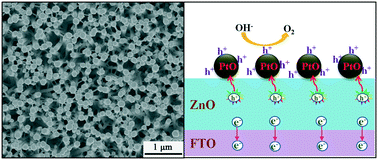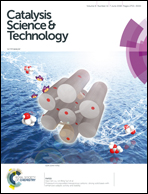ZnO nanowire arrays decorated with PtO nanowires for efficient solar water splitting†
Abstract
Photoelectrochemical (PEC) water splitting is a promising method for storing solar energy in the form of hydrogen fuel. However, the high recombination ratios of electron–hole pairs and the sluggish kinetics of the oxygen evolution reaction (OER) severely restrict the PEC efficiency. Herein, we demonstrate that vertically-oriented PtO nanowires could be highly selectively grown on ZnO nanowire arrays to construct a novel cross-linked heterostructure by a light-controlled growth method. The key to PtO nanowire growth and interactions is based on the use of a photogenerated electric field from ZnO nanowire arrays. More importantly, these PtO nanowires are utilized, for the first time, as highly efficient OER cocatalysts in PEC water splitting systems to produce hydrogen and exhibit much higher activities than other Pt species decorated samples. Systematic studies reveal that the excellent PEC performance should be attributed to the pure PtO crystalline phase and vertically-oriented nanowire structure, which could effectively facilitate the hole trapping/transport and provide more active sites for water oxidation. These results provide a new insight and strategy to construct special structured OER cocatalysts on PEC photoanodes for enhancing water splitting performance.



 Please wait while we load your content...
Please wait while we load your content...